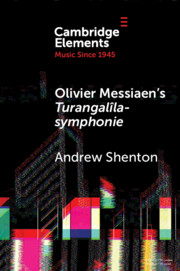32 results
Chapter 28 - Messiaen and Surrealism
- from Part IV - Concepts and Legacy
-
-
- Book:
- Messiaen in Context
- Published online:
- 09 November 2023
- Print publication:
- 30 November 2023, pp 257-266
-
- Chapter
- Export citation

Olivier Messiaen's Turangalîla-symphonie
-
- Published online:
- 11 September 2023
- Print publication:
- 05 October 2023
-
- Element
- Export citation
Statues, Spatial Syntax and Surrealism: ‘History’ and Heritagescapes in Public Space
-
- Journal:
- Transactions of the Royal Historical Society / Volume 1 / December 2023
- Published online by Cambridge University Press:
- 07 August 2023, pp. 267-290
- Print publication:
- December 2023
-
- Article
-
- You have access
- Open access
- HTML
- Export citation
24 - Libertad Bajo Palabra
- from Part II - Forms, Genre, and Media
-
-
- Book:
- The Cambridge History of American Modernism
- Published online:
- 13 July 2023
- Print publication:
- 20 July 2023, pp 413-432
-
- Chapter
- Export citation
Chapter 8 - Surrealism’s Anti-Bildungsroman
- from II - Transgression and Excess
-
-
- Book:
- A History of the Surrealist Novel
- Published online:
- 02 February 2023
- Print publication:
- 16 February 2023, pp 137-151
-
- Chapter
- Export citation
Chapter 11 - Surrealist Narratives of Trauma
- from II - Transgression and Excess
-
-
- Book:
- A History of the Surrealist Novel
- Published online:
- 02 February 2023
- Print publication:
- 16 February 2023, pp 184-202
-
- Chapter
- Export citation
Chapter 5 - Nostalgia and Childhood in the Surrealist Novel
- from I - Marvellous Beginnings
-
-
- Book:
- A History of the Surrealist Novel
- Published online:
- 02 February 2023
- Print publication:
- 16 February 2023, pp 87-101
-
- Chapter
- Export citation
Chapter 12 - Surrealism and the Science Fiction Novel
- from III - Science, Alchemy, Nature
-
-
- Book:
- A History of the Surrealist Novel
- Published online:
- 02 February 2023
- Print publication:
- 16 February 2023, pp 205-225
-
- Chapter
- Export citation
Chapter 13 - Pataphysics
- from III - Science, Alchemy, Nature
-
-
- Book:
- A History of the Surrealist Novel
- Published online:
- 02 February 2023
- Print publication:
- 16 February 2023, pp 226-241
-
- Chapter
- Export citation
Chapter 22 - Guillaume Apollinaire (1880–1918)
- from Part III - Poets
-
-
- Book:
- A History of World War One Poetry
- Published online:
- 18 January 2023
- Print publication:
- 12 January 2023, pp 365-378
-
- Chapter
- Export citation
Chapter 28 - Fictions of the Avant-Gardes
- from Part IV - Aesthetics, Culture, and Politics
-
-
- Book:
- Roberto Bolaño In Context
- Published online:
- 15 December 2022
- Print publication:
- 05 January 2023, pp 312-322
-
- Chapter
- Export citation
Chapter 13 - French Connections
- from Part II - Shaping Events and Literary History
-
-
- Book:
- Roberto Bolaño In Context
- Published online:
- 15 December 2022
- Print publication:
- 05 January 2023, pp 142-157
-
- Chapter
- Export citation
Chapter 6 - Deep Image Poetry
- from Part I - American Poetry from 1945 to 1970
-
- Book:
- The Cambridge Introduction to American Poetry since 1945
- Published online:
- 01 December 2022
- Print publication:
- 15 December 2022, pp 113-118
-
- Chapter
- Export citation
Chapter 4 - The New York School of Poetry
- from Part I - American Poetry from 1945 to 1970
-
- Book:
- The Cambridge Introduction to American Poetry since 1945
- Published online:
- 01 December 2022
- Print publication:
- 15 December 2022, pp 60-86
-
- Chapter
- Export citation
Chapter 18 - Divergence and Convergence: Avant-Garde Poetics in Twentieth-Century Spanish America and Brazil
- from Part IV - Aesthetics and Innovation
-
-
- Book:
- Latin American Literature in Transition 1930–1980
- Published online:
- 24 January 2023
- Print publication:
- 08 December 2022, pp 290-305
-
- Chapter
- Export citation
Chapter 18 - Divergence and Convergence
- from Part IV - Aesthetics and Innovation
-
-
- Book:
- Latin American Literature in Transition 1930–1980
- Published online:
- 24 January 2023
- Print publication:
- 08 December 2022, pp 290-305
-
- Chapter
- Export citation
8 - Musique automatique? Adèsian Automata and the Logic of Disjuncture
-
-
- Book:
- Thomas Adès Studies
- Published online:
- 18 November 2021
- Print publication:
- 25 November 2021, pp 163-187
-
- Chapter
- Export citation
Mrs. Rockefeller’s Exquisite Corpse
-
- Journal:
- Comparative Studies in Society and History / Volume 63 / Issue 4 / October 2021
- Published online by Cambridge University Press:
- 19 October 2021, pp. 768-797
-
- Article
- Export citation
Chapter 25 - Dreams
- from Part V - Identity
-
-
- Book:
- Elizabeth Bishop in Context
- Published online:
- 06 August 2021
- Print publication:
- 26 August 2021, pp 291-301
-
- Chapter
- Export citation
Chapter 14 - Surrealism and the Avant-Garde
- from Part III - Literary Contexts
-
-
- Book:
- Elizabeth Bishop in Context
- Published online:
- 06 August 2021
- Print publication:
- 26 August 2021, pp 163-173
-
- Chapter
- Export citation



